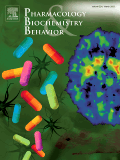.jpg)
“There is no published study regarding the interaction between muscarinic receptor modulators and antinociception induced by cannabinoidreceptor (CB2) agonist. The effect of pilocarpine (a muscarinic agonist) and atropine (a muscarinic antagonist) on JWH-133 (a CB2 agonist) induced analgesia in mice was studied. First the analgesic effect of JWH-133 (0.001-1 mg/Kg) or pilocarpine (2.5-20 mg/kg) or atropine (0.2-5 mg/kg) was evaluated. Subsequently, the effect of co-administration of pilocarpine (2.5 mg/kg) or atropine (5 mg/kg) and JWH-133 (0.001-1 mg/Kg) were studied too. JWH-133 and pilocarpine provoked antinociception in mice but atropine did not. Pilocarpine potentiated the analgesic effect of JWH-133 but atropine antagonized that. It can be concluded that JWH-133 induced antinociception is affected by muscarinic receptor modulators in mice.”





